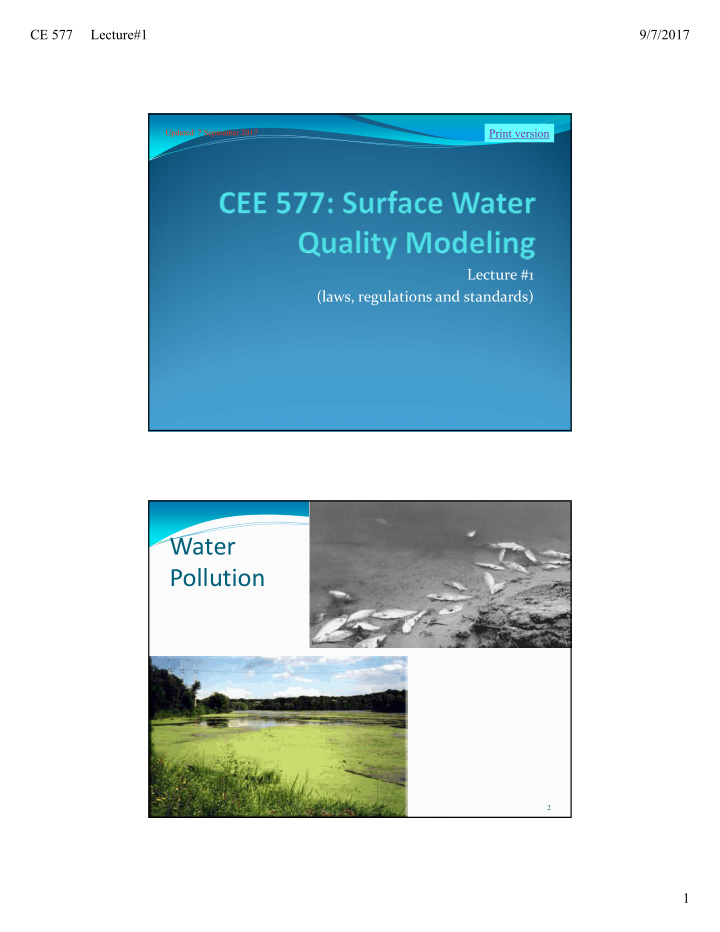



CE 577 Lecture#1 9/7/2017 Print version Updated: 7 September 2017 Lecture #1 (laws, regulations and standards) Water Pollution David A. Reckhow CEE 577 #1 2 1
CE 577 Lecture#1 9/7/2017 More Pollution David A. Reckhow CEE 577 #1 3 Outline Laws and Regulations USEPA History Wastewater Natural Waters Regulatory Methods Environmental Quality Based Effluent Based Water Quality Modeling Objectives Loading Rates David A. Reckhow CEE 577 #1 4 2
CE 577 Lecture#1 9/7/2017 Laws and Regulations Laws: passed by a majority of both legislative houses and signed by the President Regulations: established by executive branch (USEPA) in response to laws propose in Federal Register public comment and modification promulgation: into Code of Federal Regulations (CFR Part 40) David A. Reckhow CEE 577 #1 5 USEPA Regional Addresses U.S. EPA Region 1 U.S. EPA Region 2 JFK Building 26 Federal Plaza Boston, MA 02203 New York, NY 10278 U.S. EPA Region 3 U.S. EPA Region 4 841 Chestnut Street 345 Courtland Street, NE Philadelphia, PA 19107 Atlanta, GA 30365 U.S. EPA Region 5 U.S. EPA Region 6 77 West Jackson Blvd. First Interstate Bank Tower Chicago, IL 60604 1445 Ross Avenue, Suite 1200 Dallas, TX 75202 U.S. EPA Region 7 U.S. EPA Region 8 726 Minnesota Avenue 999 18th Street, Suite 1500 Kansas City, KS 66101 Denver, CO 80202 U.S. EPA Region 9 U.S. EPA Region 10 75 Hawthorne Street 1200 Sixth Avenue San Francisco, CA 94105 Seattle, WA 98101 David A. Reckhow CEE 577 #1 6 3
CE 577 Lecture#1 9/7/2017 USEPA Region #1 Region 1 David A. Reckhow CEE 577 #1 7 Legislative History 1899: Rivers and Harbors Act Prohibited disposal of solid objects in navigable waters 1948: Water Pollution Control Act first national water quality legislation 1966: Clean Rivers Restoration Act 1970: National Environmental Policy Act (NEPA) required an Environmental Impact Statement (EIS) for all federally ‐ funded projects David A. Reckhow CEE 577 #1 8 4
CE 577 Lecture#1 9/7/2017 Legislative History (cont.) 1970: USEPA formed 1972: Federal Water Pollution Control Act PL 92 ‐ 500 subsequently amended and now called the Clean Water Act established water quality goals “fishable & swimmable” and timetable established National Pollution Discharge Elimination System (NPDES) construction grants for WW treatment David A. Reckhow CEE 577 #1 9 PL 92‐500 policies (cont.) Comprehensive Pollution Control Planning Programs 106 ‐ State Work Plans or Program Summaries 201 ‐ POTW Facilities Planning 205 ‐ Statewide Planning 208 ‐ Areawide Planning 209 ‐ Interstate River Basin Planning 305 ‐ Inventory of Point Sources & Water Quality 303c ‐ Water Quality Implementation Plans Basis for current WQ standards program 303d ‐ List of waters needing TMDL Impaired & threatened waters, Impaired by pollutants 303e – develop plans for TMDLs 319 ‐ Nonpoint Source Control Planning David A. Reckhow CEE 577 #1 10 5
CE 577 Lecture#1 9/7/2017 Legislative History (cont.) 1977: Clean Water Act Amendments Best Available Technology (BAT) for 21 Industrial Categories for removal of 65 (later 126) "priority pollutants". 1987: Water Quality Act Forced States to adopt numerical criteria for priority pollutants Addressed non ‐ point sources Great Lakes Program (1990) 1988: Federal Clean Water Act Revisions waterbodies that are listed on the 303d list must be brought into compliance using a “Total Maximum Daily Load or other watershed approach.” for more information, see: EPA’s CWA History page The Clean Water Act with Amendments, WPCF 1982 The Clean Water Act 20 Years Later, Adler et al., 1993 David A. Reckhow CEE 577 #1 11 Historical Regulatory Methods Environmental Quality ‐ Based Standards cannot degrade environment beyond a certain level dependent on immediate environment more flexible Effluent ‐ Based Standards cannot discharge above a certain level of pollutant independent of immediate environment easier to establish and monitor David A. Reckhow CEE 577 #1 12 6
CE 577 Lecture#1 9/7/2017 David A. Reckhow CEE 577 #1 13 https://en.wikipedia.org/wiki/2015_Gold_King_Mine_waste_water_spill David A. Reckhow CEE 577 #1 14 7
CE 577 Lecture#1 9/7/2017 Gold King Mine Spill David A. Reckhow CEE 577 #1 15 David A. Reckhow CEE 577 #1 16 8
CE 577 Lecture#1 9/7/2017 David A. Reckhow CEE 577 #1 17 To next lecture David A. Reckhow CEE 577 #1 18 9
Recommend
More recommend